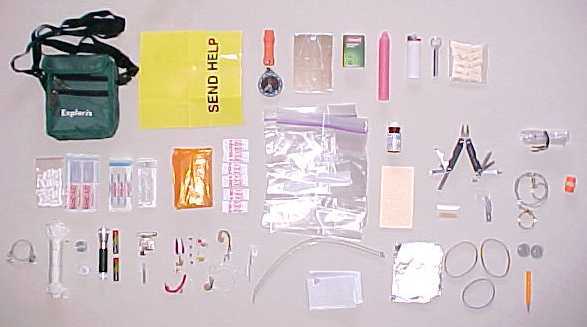

I know the photo's not the greatest, but neither is the digital camera I borrowed and am still learning how to use! Anyway, here are the complete contents of the kit, starting with the top row and moving from left to right:
TOP ROW: 6-pocket nylon pouch, 'Send Help' signal panel, whistle and compass, signal mirror, waterproof matches, candle, lighter, flint/magnesium sparking stick, waterproof Tinder Tabs.
MIDDLE ROW: Tylenol caplets, 2 large bandages, 3 medium bandages, 3 small bandages, poncho, salt packets, 3 1-quart freezer bags, water purification tablets in glass bottle, compressed sponge, multi-tool, razor blade, 2 razorknife blades (taped together), plastic tubing, wire saw, flagging ribbon.
BOTTOM ROW: wire fishing leaders, nylon cord, fishing line, dental floss (both on small plastic spools), flashlight and 2 batteries, safety pins, nails, spoon lure, worm lure, split shot, 2 dry fly lures, 2 large fish hooks, 3 medium/2 small fish hooks, 3 needles, plastic cable ties, duct tape (on paper backing), foil, rubber bands, quarters, pencil stub.
All of it fits, somehow, into the carrying pouch. Total weight is a shade under 1 1/2 pounds, and I am always looking for ways to decrease the weight and increase the functionality. One of those never-ending stories.
One of the keys to assembling a survival kit is to think 'dual use': Can I use this item to do more than one thing, and if so, what? For example, I include three wire fishing leaders. They can be used to assemble a fishing rig, sure, but they can also be put to use without any modifications as snares for small animals, or the wire can be used to repair some other vital piece of equipment. The plastic cable ties can be used to join sticks together for shelter building, to repair gear, to secure something that you really don't want to lose, or, in the final expedient, as an emergency tourniquet if you lose a finger, hand or other limb.
Things that might dissolve, melt or otherwise make a mess are segregated into smaller zip closure plastic bags. That is also done with items that would normally be used together, like the fishing kit or the first aid items, to create separate 'modules' that can be pulled out individually instead of unpacking the entire kit.
This is also a good place to remind everyone about expiration dates - note them down and check your kit at least once a year! Medications degrade over time, tape can lose its ability to stick, matches won't ignite, the lighter will have lost all of its gas, batteries will be dead, etc., etc. The time to find out that something in your survival kit isn't working is NOT when you are in a survival situation.
Return to Personal Survival Kits
This page was last updated Dec. 10, 2003
